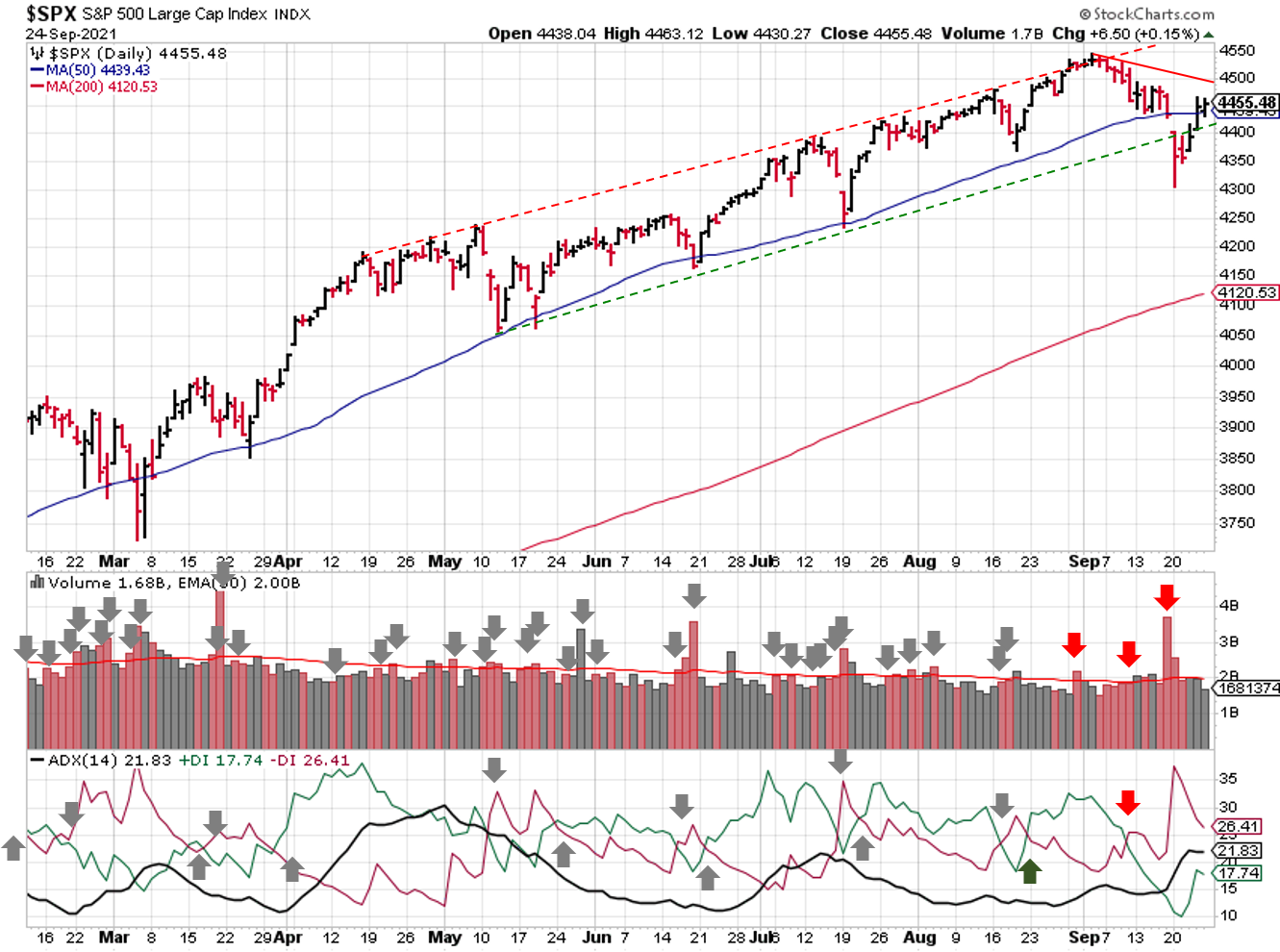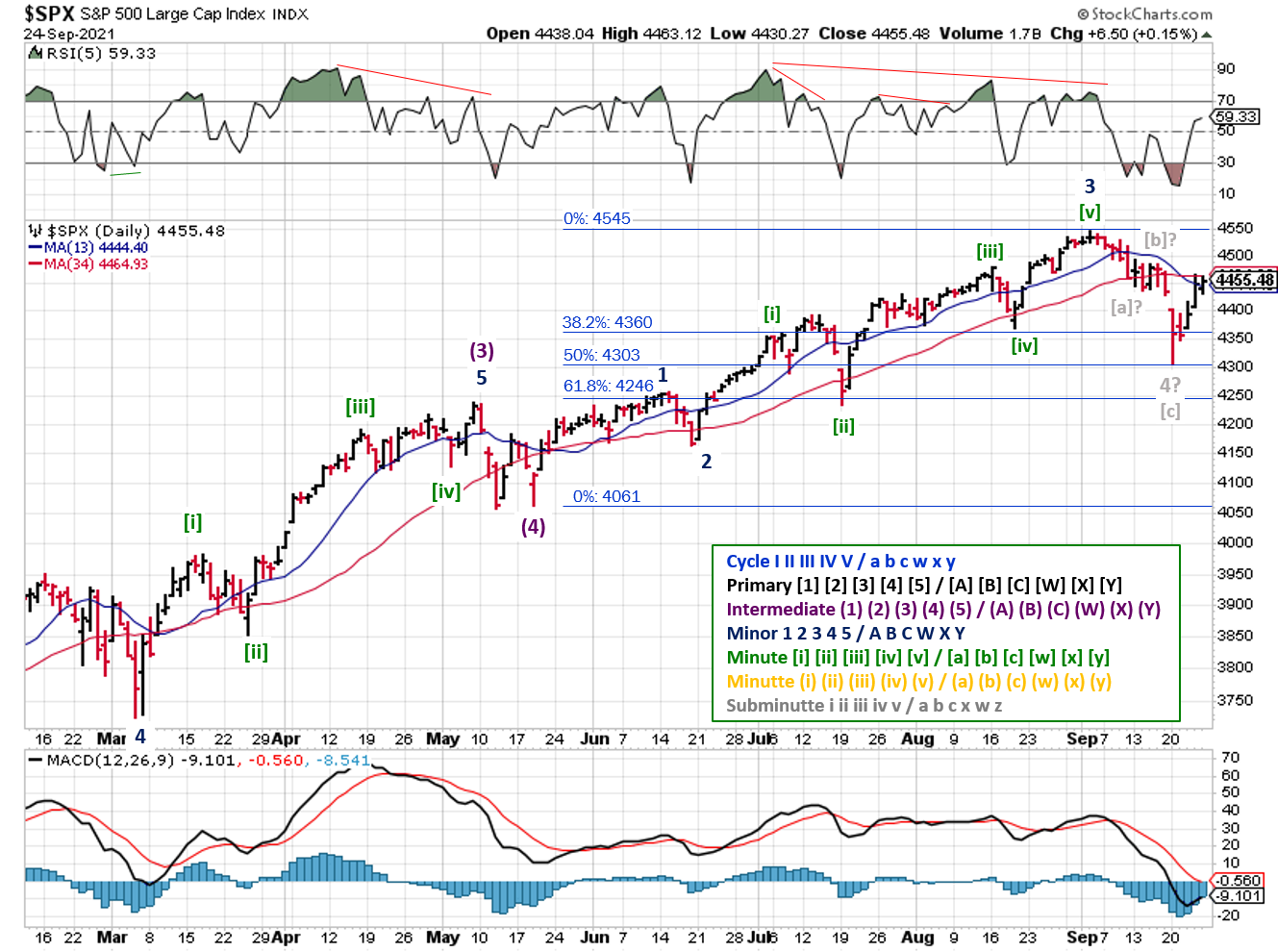Stock Market Outlook
For The Week Of September 26th = Uptrend
INDICATORS
-
ADX Directional Indicators: Downtrend
Price & Volume Action: Uptrend
Elliott Wave Analysis: Mixed
The S&P500 ($SPX) gapped down last Monday, breaking through the 50-day moving average and the price channel pattern. But by week's end, most of that damage was undone, with the index closing back above the 50-day.
2021-09-26-SPX Trendline Analysis - Daily
The ADX signal remains bearish, as does the signal.
The price and volume signal switches to an uptrend to start the week. The index retook the 50-day moving average, and distribution days are low at the moment.
2021-09-26-SPX Elliott Wave Analysis - Daily - Primary 1
Going off of Monday’s Elliott Wave update, it’s possible that:
- The correction is over: Wave 4 completed, and we’re into Wave 5 (shown in grey)
- The correction will retest the 4300 low: Wave [a] of Wave 4 completed, we’re in Wave [b], and Wave [c] will complete the correction (probably near the 62% retracement or 4,246)
COMMENTARY
All told, the S&P500 corrected ~5% from the early September high point. Unless you're 100% invested in the index, I'd bet your holdings moved a bit more than that...doubly so if you're holding small cap stocks or anything in the emerging markets. Outside of the S&P500, many equities took the summer off and have been correcting for the past couple of months.
Let's not forget that we still have October's volatility to "enjoy", and there are still wild cards out there, such as raising the U.S. debt ceiling to avoid default, funding for the U.S. Government, and any real estate related issues coming out of China.
Failure to raise the debt ceiling would have the largest impact on your holdings, but is also the least likely to occur. That doesn't mean we can't or won't see volatility as politicians posture for the media.
Regardless of the narrative, last week served as another reminder of how quickly prices can move in today's financial markets. Given the record levels of margin currently being used for trading and investing, this kind of volatility is to be expected.
Source: Advisor Perspectives
Margin debt will also amplify the speed and size of the next bear market, whenever it comes; bad news for those that are caught unaware, but great news for those with cash to invest (see the kind of bargains there were back int March 2020!).
Make your plunge protection plans now, while the markets are relatively calm, and you can profit when there's "blood in the streets" so to speak.
Best to Your Week!
If you find this research helpful, please tell a friend. If you don't find it helpful, tell an enemy.
I regularly share articles and other news of interest via on Twitter (@investsafely), Facebook, Linkedin, and Instagram (@investsafely)

How to Make Money in Stocks: A Winning System in Good Times and Bad.
It's one of my favorites.
Charts provided courtesy of stockcharts.com.
For historical Elliott Wave Analysis, go to ELLIOTT WAVE lives on by Tony Caldaro. Other interpretations can be found at: Pretzel Logic, and 12345ABCDEWXYZ
Once a year, I review the market outlook signals as if they were a mechanical trading system, while pointing out issues and making adjustments. The goal is to give you to give you an example of how to analyze and continuously improve your own systems.
- 2015 Performance - Stock Market Outlook
- 2016 Performance - Stock Market Outlook
- 2017 Performance - Stock Market Outlook
- 2018 Performance - Stock Market Outlook
- 2019 Performance - Stock Market Outlook
- 2020 Performance - Stock Market Outlook
IMPORTANT DISCLOSURE INFORMATION
This material is for general communication and is provided for informational and/or educational purposes only. None of the content should be viewed as a suggestion that you take or refrain from taking any action nor as a recommendation for any specific investment product, strategy, or other such purpose. Certain information contained herein has been obtained from third-party sources believed to be reliable, but we cannot guarantee its accuracy or completeness.
To the extent that a reader has any questions regarding the applicability of any specific issue discussed above to his/her individual situation, he/she is encouraged to consult with the professional advisors of his/her choosing. Invest Safely, LLC is not a law firm, certified public accounting firm, or registered investment advisor and no portion of its content should be construed as legal, accounting, or investment advice.
The material is not to be construed as an offer or a recommendation to buy or sell a security nor is it to be construed as investment advice. Additionally, the material accessible through this website does not constitute a representation that the investments described herein are suitable or appropriate for any person.
Hypothetical Presentations:
Any referenced performance is “as calculated” using the referenced funds and has not been independently verified. This presentation does not discuss, directly or indirectly, the amount of the profits or losses, realized or unrealized, by any reader or contributor, from any specific funds or securities.
The author and/or any reader may have experienced materially different performance based upon various factors during the corresponding time periods. To the extent that any portion of the content reflects hypothetical results that were achieved by means of the retroactive application of a back-tested model, such results have inherent limitations, including:
Model results do not reflect the results of actual trading using assets, but were achieved by means of the retroactive application of the referenced models, certain aspects of which may have been designed with the benefit of hindsight
Back-tested performance may not reflect the impact that any material market or economic factors might have had on the use of a trading model if the model had been used during the period to actually manage assets
Actual investment results during the corresponding time periods may have been materially different from those portrayed in the model
Past performance may not be indicative of future results. Therefore, no one should assume that future performance will be profitable, or equal to any corresponding historical index.
The S&P 500 Composite Total Return Index (the "S&P") is a market capitalization-weighted index of 500 widely held stocks often used as a proxy for the stock market. Standard & Poor's chooses the member companies for the S&P based on market size, liquidity, and industry group representation. Included are the common stocks of industrial, financial, utility, and transportation companies. The S&P is not an index into which an investor can directly invest. The historical S&P performance results (and those of all other indices) are provided exclusively for comparison purposes only, so as to provide general comparative information to assist an individual in determining whether the performance of a specific portfolio or model meets, or continues to meet investment objective(s). The model and indices performance results do not reflect the impact of taxes.
Investing involves risk (even the “safe” kind)! Past performance does not guarantee or indicate future results. Different types of investments involve varying degrees of underlying risk. Therefore, do not assume that future performance of any specific investment or investment strategy be suitable for your portfolio or individual situation, will be profitable, equal any historical performance level(s), or prove successful (including the investments and/or investment strategies describe on this site).





